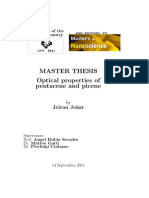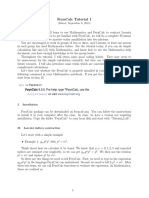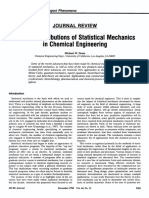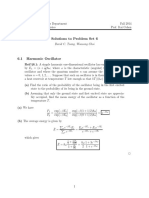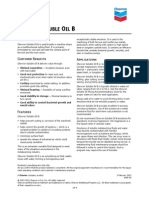3 Free Electron Theory of Metals: 3.1 Drude Model
Uploaded by
justinl13755353 Free Electron Theory of Metals: 3.1 Drude Model
Uploaded by
justinl13755353
FREE ELECTRON THEORY OF METALS
3.1 Drude Model
The most important characteristic of a metal is its high electrical conductivity.
Around 1900, shortly after J. J. Thompsons discovery of the electron, people
became interested in understanding more about the mechanism of metallic
conduction. The rst work by E. Riecke in 1898 was quickly superseded by
that of Drude in 1900. Drude
1
proposed an exceedingly simple model that ex-
plained a well-known empirical law, the WiedermannFranz law (1853). This
law stated that at a given temperature the ratio of the thermal conductivity
to the electrical conductivity was the same for all metals. The assumptions of
the Drude model are:
(i) a metal contains free electrons which form an electron gas.
(ii) the electrons have some average thermal energy
1
2
mv
2
T
, but they pursue
random motions through the metal so that 'v
T
` = 0 even though
v
2
T
=
0. The random motions result from collisions with the ions.
(iii) because the ions have a very large mass, they are essentially immovable.
3.2 Electrical Conductivity
In the presence of an electric eld E the electrons acquire a drift velocity
v
D
which is superimposed on the thermal motion. Drude assumed that the
probability that an electron collides with an ion during a time interval dt is
simply proportional to
dt
, where is called the collision time or relaxation
time. Then Newtons law gives
m
dv
D
dt
+
v
D
= eE, (3.1)
1
P. Drude, Annalen der Physik 1, 566 (1900); ibid., 3, 369 (1900); ibid., 7, 687
(1902).
78 3 FREE ELECTRON THEORY OF METALS
where e is the charge on an electron. Some appreciation of the term of
relaxation time
dt
can be obtained by assuming that the system acquires a
drift velocity v
D
in the presence of an electric eld E, and then, at time t = 0,
the electric eld is turned o. The behavior of v
D
(t) as a function of time is
given by
v
D
(t) = v
D
(0)e
t/
, (3.2)
showing that v
D
relaxes from v
D
(0) toward zero with a relaxation time .
In the steady state (where v
D
= 0), v
D
is given by
v
D
=
eE
m
. (3.3)
The quantity
e
m
, the drift velocity per unit electric eld, is called , the
drift mobility. The velocity of an electron including both thermal and drift
components is
v = v
T
eE
m
. (3.4)
The current density caused by the electric eld E is simply
j = V
1
all
electrons
(e)v. (3.5)
But
all
electrons
v
T
= 0, so that
j = V
1
N(e)
eE
m
= E. (3.6)
Here , the electrical conductivity, is equal to
n
0
e
2
m
where n
0
=
N
V
is the
electron concentration.
3.3 Thermal Conductivity
The thermal conductivity is the ratio of the thermal current (i.e., the energy
current) to the magnitude of the temperature gradient. In the presence of a
temperature gradient
T
x
, the average thermal energy
1
2
mv
2
T
will depend
on the local temperature T(x). The electrons sense the local temperature
through collisions with the lattice. Thus, the thermal energy of a given electron
will depend on where it made its last collision. If we choose an electron at
random, the mean time back to its last collision is . Therefore, an electron
crossing the plane x = x
0
at an angle to the x-axis had its last collision
at x = x
0
v
T
cos . (See Figure 3.1.) The energy of such an electron is
E(x) = E (x
0
v
T
cos ). The number of electrons per unit volume whose
direction of motion is in the solid angle d is simply n
0
d
4
. (See Figure 3.2.)
3.3 Thermal Conductivity 79
G
G
Fig. 3.1. An electron crossing the plane x = x
0
at an angle to the x-axis
The number of such electrons crossing a unit area at x
0
is n
0
d
4
v
T
cos , giving
for the energy ux through a unit area at x
0
w(x
0
) =
E (x
0
v
T
cos ) n
0
v
T
cos
d
4
. (3.7)
Just as we did for the thermal conductivity due to phonons we expand
E (x
0
v
T
cos ) and perform the integral over from 0 to . This gives
w(x) =
1
3
n
0
v
2
T
E
x
. (3.8)
But
E
x
=
E
T
T
x
, so the thermal conductivity is given by
=
w
T/x
=
1
3
n
0
v
2
T
dE
dT
=
1
3
v
2
T
C
v
, (3.9)
where C
v
= n
0
dE
dT
is the heat capacity per unit volume (or the specic heat).
d
2 sin d d =
Fig. 3.2. Solid angle d in which electrons moving to cross the plane x = x
0
at an
angle to the x-axis
80 3 FREE ELECTRON THEORY OF METALS
3.4 WiedemannFranz Law
The ratio of to is given by
=
1
3
v
2
T
C
v
n
0
e
2
m
. (3.10)
Now Drude applied the classical gas laws to evaluation of v
2
T
and C
v
, viz.,
1
2
mv
2
T
=
3
2
k
B
T and C
v
= n
0
3
2
k
B
. This gave
=
3
2
k
B
e
2
T. (3.11)
In addition to agreeing with the WiedemannFranz law, the ratio L =
T
had
the value
3
2
k
B
e
2
which was equal to 1.24 10
13
esu. The observed values
for L, called the Lorenz number
2
, averaged to roughly 2.72 10
13
esu.
Drude made an error of a factor of 2 in his original paper and found that
L 2.48 10
13
esu, remarkably close to the experimental value.
3.5 Criticisms of Drude Model
1. If
1
2
mv
2
T
=
3
2
k
B
T, then the electronic contribution to C
v
had to be
C
v
=
3
2
Nk
B
=
3
2
R. This is half as big as the lattice contribution and was
simply not observed.
2. Experimentally varies as T
1
. This implies that n
0
T
1
since e
2
and m are constants. In Drudes picture, the mean free path l v
T
was
thought to be of the order of the atomic spacing and therefore independent
of T. Since v
T
T
1/2
this would imply that T
1/2
and, to satisfy
n
0
T
1
, that n
0
T
1/2
. This did not make any sense.
3.6 Lorentz Theory
Since Drudes simple model gave some results that agree fairly well with ex-
periment, Lorentz
3
decided to use the full apparatus of kinetic theory to inves-
tigate the model more carefully. He did not succeed in improving on Drudes
model, but he did make use of the Boltzmann distribution function and Boltz-
mann equation which we would like to describe.
2
Ludvig Valentin Lorenz (1829-1891).
3
Hendrik Antoon Lorentz (1853-1928).
3.6 Lorentz Theory 81
3.6.1 Boltzmann Distribution Function
The Boltzmann distribution function f (v, r, t) is dened by
f(v, r, t)d
3
rd
3
v = the number of electrons in the volume element d
3
r centered
at r whose velocity is between v and v +dv at time t.
Boltzmanns equation says that the total time rate of change of f (v, r, t) must
be balanced by its time rate of change due to collisions, i.e.,
df (v, r, t)
dt
=
f
t
c
. (3.12)
Here
f
t
c
d
3
r d
3
v dt is the net number of electrons forced into the volume
element d
3
rd
3
v (in phase space) by collisions in the time interval dt.
3.6.2 Relaxation Time Approximation
The simplest form of the collision term is
f
t
c
=
f f
0
, (3.13)
where f
0
is the thermal equilibrium distribution function, f the actual
nonequilibrium distribution function (which diers from f
0
due to some ex-
ternal disturbance), and is a relaxation time. Once again if f f
0
is nonzero
due to some external disturbance, and if at time t = 0 the disturbanceis turned
o, one can simply write
(f f
0
)
t
= (f f
0
)
t=0
e
t/
. (3.14)
3.6.3 Solution of Boltzmann Equation
We are frequently interested in small perturbations away from equilibrium
and can linearize the Boltzmann equation. For example, suppose the external
perturbation is a small electric eld E in the x-direction, and a temperature
gradient
T
x
. The steady state Boltzmann equation (
f
t
= 0) is
f
v
x
eE
m
+
f
x
v
x
=
f f
0
. (3.15)
If f f
0
is small we can approximate f on the left hand side by f
0
and obtain
f f
0
+
eE
m
f
0
v
x
v
x
f
0
x
. (3.16)
This is linear response since E and
f
0
x
are already linear in E or
T
x
. The
electrical current density and thermal current density are given, respectively,
by
82 3 FREE ELECTRON THEORY OF METALS
j(r, t) =
(e)v f (r, v, t) d
3
v, (3.17)
and
w(r, t) =
v f (r, v, t) d
3
v. (3.18)
In Eq.(3.18) =
1
2
mv
2
is the kinetic energy of the electron of velocity v. We
substitute the solution for f given by Eq.(3.16) into Eqs.(3.17) and (3.18) to
calculate j and w.
3.6.4 MaxwellBoltzmann Distribution
To evaluate j and w it is necessary to know f
0
(v). Lorentz used the following
expression
f
0
(v) = n
0
m
2
3/2
e
/
. (3.19)
Here n
0
= N/V , = k
B
T, and =
1
2
mv
2
. The normalization constant
has been chosen so that
f
0
(v)d
3
v = n
0
. The reader should check this. (Use
0
x
1/2
e
x
dx = (
3
2
) =
2
.)
The use of classical statistical mechanics and the MaxwellBoltzmann dis-
tribution function is the source of the diculty with the Lorentz theory. In
1925 Pauli
4
proposed the exclusion principle; in 1926 Fermi and Dirac
5
pro-
posed the FermiDirac statistics, and in 1928 Sommerfeld published the Som-
merfeld Theory of Metals. The Sommerfeld theory was simply the Lorentz
theory with the FermiDirac distribution function replacing the Boltzmann
Maxwell distribution function.
3.7 Sommerfeld Theory of Metals
Sommerfeld
6
treated the Drude electron gas quantum mechanically. We can
assume that the electron gas is contained in a cubic box of edge L, and that
the potential inside the box is constant. The Schrodinger equation is
h
2
2m
2
(r) = E(r), (3.20)
and its solution is
k
(r) = V
1/2
e
ikr
(3.21)
E
k
=
h
2
k
2
2m
.
4
W. Pauli, Z. Physik 31, 765 (1925).
5
E. Fermi, Z. Physik 36, 902 (1926); P. A. M. Dirac, Proc. Roy. Soc. London, A
112, 661 (1926).
6
A. Sommerfeld, Zeits. fur Physik 47, 1 (1928).
3.8 Review of Elementary Statistical Mechanics 83
To avoid diculties with boundaries, we can assume periodic boundary con-
ditions so that x = 0 and x = L are the same point. Then the allowed values
of k
x
(and k
y
and k
z
) satisfy k
x
=
2
L
n
x
, where n
x
= 0, 1, 2, , and
E
k
=
h
2
2m
2
L
n
2
x
+n
2
y
+n
2
z
. (3.22)
The functions [k` form a complete orthonormal set with
'k[k
` =
d
3
r
k
(r)
k
(r) =
kk
. (3.23)
k
[k` 'k[ = 1 or
k
(r
)
k
(r) = (r
r). (3.24)
Fermi Energy
The Pauli principle states that only one electron can occupy a given quantum
state. In the Sommerfeld model, states are labelled by k, = (k
x
, k
y
, k
z
) and ,
where is a spin index which takes on the two values or . At T = 0, only
the lowest N energy states will be occupied by the N electrons in the system.
Dene k
F
as the value of k for the highest energy occupied state. Then the
number of particles is given by
N =
k < k
F
1 =
V
(2)
3
2
k<k
F
d
3
k. (3.25)
The factor of 2 comes from summing over spin. The integration simply gives
4
3
k
3
F
, resulting in the relation
k
3
F
= 3
2
n
0
. (3.26)
The Fermi energy
F
(
F
), Fermi velocity v
F
, and Fermi tempera-
ture T
F
=
F
k
B
are dened, respectively, by
F
=
h
2
k
2
F
2m
=
1
2
mv
2
F
=
F
. (3.27)
For a typical metal, we have n
0
= 10
23
cm
3
giving
F
5 eV, v
F
10
8
cm/sec, and T
F
10
5
K.
3.8 Review of Elementary Statistical Mechanics
Suppose that the states of an ideal Fermi gas are labelled
1
,
2
, ,
i
,
and that they have energies
1
,
2
, ,
i
, . Then if N is the total number
of Fermions
84 3 FREE ELECTRON THEORY OF METALS
i
n
i
= N, (3.28)
where n
i
= 1 if the state
i
is occupied and n
i
= 0 if it is not. The partition
function Z
N
for this N particle system is dened by
Z
N
=
{n
i
}
e
i
n
i
i
. (3.29)
In Eq.(3.29) = (k
B
T)
1
and the symbol
{n
i
}
means a summation over all
sets of values n
i
= n
1
, n
2
, , n
i
, which satisfy the condition
i
n
i
= N.
This restriction makes performing the sum to obtain Z
N
dicult. One can
avoid this diculty by using the grand canonical ensemble instead of the
canonical ensemble. The grand partition function Q is dened by
Q =
N=0
e
N
Z
N
. (3.30)
The symbol is is called the chemical potential. When we substitute
Eq.(3.29) into Eq.(3.30), the summation over N removes the restriction on
the sets of values n
i
included in the sum appearing in Eq.(3.29). We can
rewrite the grand partition function as follows:
Q =
N=0
{n
i
}
e
i
n
i
(
i
)
(3.31)
=
1
n
1
=0
1
n
2
=0
1
n
i
=0
e
(
1
)n
1
e
(
2
)n
2
e
(
i
)n
i
.
It is easy to see that
1
n
i
=0
e
(
i
)n
i
= 1 + e
(
i
)
so that
Q =
1 + e
(
i
)
. (3.32)
The average occupancy of some quantum state l is given by
n
l
= Q
1
{n
i
}
n
l
e
i
n
i
(
i
)
. (3.33)
For all i = l, the factor involving i in the numerator is exactly cancelled by
the same factor in Q
1
leaving us
3.8 Review of Elementary Statistical Mechanics 85
n
l
=
n
l
n
l
e
(
l
)n
l
n
l
e
(
l
)n
l
=
e
(
l
)
1 + e
(
l
)
. (3.34)
Thus we nd the FermiDirac distribution function of
n
l
=
1
e
(
l
)/
+ 1
. (3.35)
At = 0 all states whose energy is smaller than
F
are occupied; all states
of higher energy empty. Notice that Eq.(3.33) can be written
n
l
= k
B
T
l
lnQ, (3.36)
a form that is sometimes useful.
3.8.1 FermiDirac Distribution Function
At zero temperature the FermiDirac distribution function can be written, as
a function of energy , as
f
0
() =
1 if <
F
,
0 if >
F
.
(3.37)
At a nite temperature
f
0
() =
1
e
()/
+ 1
. (3.38)
Clearly at = , f
0
( = ) is equal to
1
2
. (See Figure 3.3.) The value of is
determined (as a function of T) by the condition
k
f
0
(
k
) = N. (3.39)
6
6
Fig. 3.3. FermiDirac distribution function f
0
() for two dierent temperatures
86 3 FREE ELECTRON THEORY OF METALS
3.8.2 Density of States
It is easiest to determine G(), the total number of states per unit volume
whose energy is less than , and then obtain g() from it.
G( +d) G() =
dG
d
d = g()d. (3.40)
For free electrons we have
G() = V
1
k
1 =
2
(2)
3
4
3
k
3
, (3.41)
where
h
2
k
2
2m
= . It is easy to see that
G() = n
0
k
k
F
3
= n
0
3/2
. (3.42)
Thus, from Eq.(3.40) we nd
g() =
3
2
n
0
1/2
=
1
2
2
2m
h
2
3/2
1/2
. (3.43)
For electrons moving in a periodic potential, g() does not have such a simple
form.
At a nite temperature , the number of electrons per unit volume having
energies between and + d is simply the product of g()d and f
0
():
n()d = g()f
0
()d. (See Figure 3.4.) The chemical potential is determined
from
N = V
0
g()f
0
()d. (3.44)
Fig. 3.4. Particle density n() and the density of states g()
3.8 Review of Elementary Statistical Mechanics 87
3.8.3 Thermodynamic Potential
The thermodynamic potential is dened by
= lnQ =
i
ln
1 + e
(
i
)/
. (3.45)
Functions that are commonly used in statistical mechanics are:
internal energy U,
Helmholtz free energy F = U TS,
Thermodynamic potential = U TS N = PV, (3.46)
enthalpy H = U +PV = TS +N,
Gibbs free energy G = U TS +PV = N.
These denitions together with Eulers relation
U = TS PV +N, (3.47)
and the second law of thermodynamics
dU = TdS PdV +dN (3.48)
are very useful to remember. By using Eqs.(3.47) and (3.48) and = PV ,
one can obtain
d = SdT PdV Nd. (3.49)
From Eq.(3.49) one can see that the entropy S, pressure P and particle number
N can be obtained from the thermodynamic potential
S =
V,
,
P =
T,
, (3.50)
N =
V,T
.
3.8.4 Entropy
We know that
=
i
ln
1 + e
(
i
)/
. (3.51)
But we can write
1 n
i
= 1
1
e
(
i
)/
+ 1
=
1
e
(
i
)/
+ 1
, (3.52)
88 3 FREE ELECTRON THEORY OF METALS
so that
ln(1 n
i
) = ln
1 + e
(
i
)/
. (3.53)
We can express Eq.(3.51) as
=
i
ln(1 n
i
) . (3.54)
Since the entropy is given by S =
, we can obtain
S =
i
ln(1 n
i
) +
i
(1 n
i
)
1
n
i
. (3.55)
Evaluating
n
i
and multiplying by (1 n
i
)
1
gives
1 n
i
n
i
= n
i
ln
1 n
i
n
i
. (3.56)
Sustituting this result into Eq.(3.55) gives
S = k
B
i
[(1 n
i
) ln(1 n
i
) + n
i
ln n
i
] . (3.57)
We have inserted the factor k
B
into Eq.(3.57); in the derivation we had essen-
tially set it equal to unity. Notice that the expression for S goes to zero as T
goes to zero because n
i
takes on the values 0 or 1 in this limit. In addition we
can write that
S =
ln(1 n
i
) + n
i
ln
n
i
1 n
i
,
=
i
ln(1 n
i
)
i
n
i
,
=
i
ln(1 n
i
)
i
n
i
+
i
n
i
i
, (3.58)
=
i
ln(1 n
i
) N +U.
If we write F = U TS we have
F = N +
i
ln(1 n
i
) , (3.59)
= N
i
ln
1 + e
.
If we hold V and T constant, the energy levels
i
are unchanged and
You might also like
- Basic Space Plasma Physics - Revised EditionNo ratings yetBasic Space Plasma Physics - Revised Edition17 pages
- Physics 304 Thermodynamics Notes: An Introduction To Thermal Physics, D. V. Schroeder, Addison Wesley Longman, 2000No ratings yetPhysics 304 Thermodynamics Notes: An Introduction To Thermal Physics, D. V. Schroeder, Addison Wesley Longman, 200057 pages
- (Oxford Graduate Texts) Henrik Bruus, Karsten Flensberg-Many-body Quantum Theory in Condensed Matter Physics-Oxford University Press, USA (2004)No ratings yet(Oxford Graduate Texts) Henrik Bruus, Karsten Flensberg-Many-body Quantum Theory in Condensed Matter Physics-Oxford University Press, USA (2004)352 pages
- Plasblak Masterbatches: Product Selection GuideNo ratings yetPlasblak Masterbatches: Product Selection Guide8 pages
- Chemistry of Textile Fibres & Their Properties100% (4)Chemistry of Textile Fibres & Their Properties24 pages
- Treatise on Irreversible and Statistical Thermodynamics: An Introduction to Nonclassical ThermodynamicsFrom EverandTreatise on Irreversible and Statistical Thermodynamics: An Introduction to Nonclassical ThermodynamicsNo ratings yet
- Nai-Chang Yeh - A Perspective of Frontiers in Modern Condensed Matter PhysicsNo ratings yetNai-Chang Yeh - A Perspective of Frontiers in Modern Condensed Matter Physics19 pages
- Nuclear and Particle Physics Lectures SumnerNo ratings yetNuclear and Particle Physics Lectures Sumner41 pages
- A modern approach to classical mechanics Iro all chapter instant downloadNo ratings yetA modern approach to classical mechanics Iro all chapter instant download55 pages
- Lecture Notes: Condensed Matter Theory I (TKM1) : J. SchmalianNo ratings yetLecture Notes: Condensed Matter Theory I (TKM1) : J. Schmalian70 pages
- (Arkani-Hamed) Lectures On Modified GravityNo ratings yet(Arkani-Hamed) Lectures On Modified Gravity16 pages
- Modern Fortran: Building Efficient Parallel Applications 1st Edition Milan Curcic 2024 Scribd Download100% (3)Modern Fortran: Building Efficient Parallel Applications 1st Edition Milan Curcic 2024 Scribd Download62 pages
- An Introduction To FISIKA STATISTIK WORDNo ratings yetAn Introduction To FISIKA STATISTIK WORD396 pages
- Basics and Principles of Particle Image Velocimetry (PIV)No ratings yetBasics and Principles of Particle Image Velocimetry (PIV)17 pages
- W. Galleas - The Bethe Ansatz Equations For Reflecting MagnonsNo ratings yetW. Galleas - The Bethe Ansatz Equations For Reflecting Magnons18 pages
- A First Book of Quantum Field Theory (Amitabha Lahiri, Palash B. Pal) (Z-Library)No ratings yetA First Book of Quantum Field Theory (Amitabha Lahiri, Palash B. Pal) (Z-Library)400 pages
- Matrix Product States For Gauge Field Theories: PACS NumbersNo ratings yetMatrix Product States For Gauge Field Theories: PACS Numbers10 pages
- Interacting Bose-Fermi Systems in Nuclei: F. IachelloNo ratings yetInteracting Bose-Fermi Systems in Nuclei: F. Iachello399 pages
- Cohen-Tannoudji - Quantum Mechanics, Vol.1No ratings yetCohen-Tannoudji - Quantum Mechanics, Vol.12 pages
- Master Thesis Optical Properties of Pentacene and Picene: University of The Basque Country WWW - Mscnano.euNo ratings yetMaster Thesis Optical Properties of Pentacene and Picene: University of The Basque Country WWW - Mscnano.eu51 pages
- Werner Krauth Statistical Mechanics Algorithms and Computations Oxford Master Series in Physics0% (1)Werner Krauth Statistical Mechanics Algorithms and Computations Oxford Master Series in Physics28 pages
- Group Theory For Physics: Kenichi KonishiNo ratings yetGroup Theory For Physics: Kenichi Konishi126 pages
- (Reidel Texts in The Mathematical Sciences 2) Harry A. Mavromatis (Auth.) - Exercises in Quantum Mechanics - A Collection of Illustrative Problems and Their Solutions-Springer Netherlands (1987) PDF100% (1)(Reidel Texts in The Mathematical Sciences 2) Harry A. Mavromatis (Auth.) - Exercises in Quantum Mechanics - A Collection of Illustrative Problems and Their Solutions-Springer Netherlands (1987) PDF190 pages
- Electron Correlation: The Many-Body Problem at The Heart of ChemistryNo ratings yetElectron Correlation: The Many-Body Problem at The Heart of Chemistry14 pages
- The Nuts and Bolts of First-Principles Simulation: 3: Density Functional TheoryNo ratings yetThe Nuts and Bolts of First-Principles Simulation: 3: Density Functional Theory14 pages
- Surface Charges and Fields of Simple Circuits: Norris W. PreyerNo ratings yetSurface Charges and Fields of Simple Circuits: Norris W. Preyer5 pages
- Classical and Statisitcal ThermodinamicsNo ratings yetClassical and Statisitcal Thermodinamics111 pages
- Instant download Computational Electrodynamics The Finite Difference Time Domain Method Third Edition Allen Taflove pdf all chapter100% (8)Instant download Computational Electrodynamics The Finite Difference Time Domain Method Third Edition Allen Taflove pdf all chapter77 pages
- Instead of the ITER project and the TOKAMAK principle: – a new type of fusion machineFrom EverandInstead of the ITER project and the TOKAMAK principle: – a new type of fusion machine5/5 (1)
- Review On The Progress of Light Harvesting Natural P - 2023 - Inorganic ChemistrNo ratings yetReview On The Progress of Light Harvesting Natural P - 2023 - Inorganic Chemistr10 pages
- Konversi Limbah Plastik Minyak: Presentation Done By: Arman Natal Purba S.T.,M.TNo ratings yetKonversi Limbah Plastik Minyak: Presentation Done By: Arman Natal Purba S.T.,M.T10 pages
- Experimental Investigations On Suffusion Characteristics and Its Mechanical Consequences On Saturated Cohesionless Soil PDFNo ratings yetExperimental Investigations On Suffusion Characteristics and Its Mechanical Consequences On Saturated Cohesionless Soil PDF18 pages
- Power FET (DMOS, VMOS) - Hansen and RoschenNo ratings yetPower FET (DMOS, VMOS) - Hansen and Roschen14 pages
- Z8148BR - AMT Brochure - IMI PE UPDATE - 050216No ratings yetZ8148BR - AMT Brochure - IMI PE UPDATE - 0502169 pages
- CAPACITANCE AND DIELECTRIC PresentationNo ratings yetCAPACITANCE AND DIELECTRIC Presentation40 pages
- Determine The Moisture and Volatile Content in The Green Sand100% (2)Determine The Moisture and Volatile Content in The Green Sand3 pages
- A Review On Seismic Assessment of Post-Tensioned Flat SlabNo ratings yetA Review On Seismic Assessment of Post-Tensioned Flat Slab5 pages
- Advanced Energy Materials - 2022 - Almora - Device Performance of Emerging Photovoltaic Materials Version 3No ratings yetAdvanced Energy Materials - 2022 - Almora - Device Performance of Emerging Photovoltaic Materials Version 328 pages
- C11 - Packaging and Materials Handling - SVNo ratings yetC11 - Packaging and Materials Handling - SV13 pages
- Mat Foundation Design: Soil Data MaterialsNo ratings yetMat Foundation Design: Soil Data Materials2 pages
- Physics 304 Thermodynamics Notes: An Introduction To Thermal Physics, D. V. Schroeder, Addison Wesley Longman, 2000Physics 304 Thermodynamics Notes: An Introduction To Thermal Physics, D. V. Schroeder, Addison Wesley Longman, 2000
- (Oxford Graduate Texts) Henrik Bruus, Karsten Flensberg-Many-body Quantum Theory in Condensed Matter Physics-Oxford University Press, USA (2004)(Oxford Graduate Texts) Henrik Bruus, Karsten Flensberg-Many-body Quantum Theory in Condensed Matter Physics-Oxford University Press, USA (2004)
- Solved Problems in Classical ElectromagnetismFrom EverandSolved Problems in Classical Electromagnetism
- Treatise on Irreversible and Statistical Thermodynamics: An Introduction to Nonclassical ThermodynamicsFrom EverandTreatise on Irreversible and Statistical Thermodynamics: An Introduction to Nonclassical Thermodynamics
- Nai-Chang Yeh - A Perspective of Frontiers in Modern Condensed Matter PhysicsNai-Chang Yeh - A Perspective of Frontiers in Modern Condensed Matter Physics
- A modern approach to classical mechanics Iro all chapter instant downloadA modern approach to classical mechanics Iro all chapter instant download
- Lecture Notes: Condensed Matter Theory I (TKM1) : J. SchmalianLecture Notes: Condensed Matter Theory I (TKM1) : J. Schmalian
- Modern Fortran: Building Efficient Parallel Applications 1st Edition Milan Curcic 2024 Scribd DownloadModern Fortran: Building Efficient Parallel Applications 1st Edition Milan Curcic 2024 Scribd Download
- Basics and Principles of Particle Image Velocimetry (PIV)Basics and Principles of Particle Image Velocimetry (PIV)
- W. Galleas - The Bethe Ansatz Equations For Reflecting MagnonsW. Galleas - The Bethe Ansatz Equations For Reflecting Magnons
- A First Book of Quantum Field Theory (Amitabha Lahiri, Palash B. Pal) (Z-Library)A First Book of Quantum Field Theory (Amitabha Lahiri, Palash B. Pal) (Z-Library)
- Matrix Product States For Gauge Field Theories: PACS NumbersMatrix Product States For Gauge Field Theories: PACS Numbers
- Interacting Bose-Fermi Systems in Nuclei: F. IachelloInteracting Bose-Fermi Systems in Nuclei: F. Iachello
- Master Thesis Optical Properties of Pentacene and Picene: University of The Basque Country WWW - Mscnano.euMaster Thesis Optical Properties of Pentacene and Picene: University of The Basque Country WWW - Mscnano.eu
- Werner Krauth Statistical Mechanics Algorithms and Computations Oxford Master Series in PhysicsWerner Krauth Statistical Mechanics Algorithms and Computations Oxford Master Series in Physics
- (Reidel Texts in The Mathematical Sciences 2) Harry A. Mavromatis (Auth.) - Exercises in Quantum Mechanics - A Collection of Illustrative Problems and Their Solutions-Springer Netherlands (1987) PDF(Reidel Texts in The Mathematical Sciences 2) Harry A. Mavromatis (Auth.) - Exercises in Quantum Mechanics - A Collection of Illustrative Problems and Their Solutions-Springer Netherlands (1987) PDF
- Electron Correlation: The Many-Body Problem at The Heart of ChemistryElectron Correlation: The Many-Body Problem at The Heart of Chemistry
- The Nuts and Bolts of First-Principles Simulation: 3: Density Functional TheoryThe Nuts and Bolts of First-Principles Simulation: 3: Density Functional Theory
- Surface Charges and Fields of Simple Circuits: Norris W. PreyerSurface Charges and Fields of Simple Circuits: Norris W. Preyer
- Instant download Computational Electrodynamics The Finite Difference Time Domain Method Third Edition Allen Taflove pdf all chapterInstant download Computational Electrodynamics The Finite Difference Time Domain Method Third Edition Allen Taflove pdf all chapter
- Instead of the ITER project and the TOKAMAK principle: – a new type of fusion machineFrom EverandInstead of the ITER project and the TOKAMAK principle: – a new type of fusion machine
- Review On The Progress of Light Harvesting Natural P - 2023 - Inorganic ChemistrReview On The Progress of Light Harvesting Natural P - 2023 - Inorganic Chemistr
- Konversi Limbah Plastik Minyak: Presentation Done By: Arman Natal Purba S.T.,M.TKonversi Limbah Plastik Minyak: Presentation Done By: Arman Natal Purba S.T.,M.T
- Experimental Investigations On Suffusion Characteristics and Its Mechanical Consequences On Saturated Cohesionless Soil PDFExperimental Investigations On Suffusion Characteristics and Its Mechanical Consequences On Saturated Cohesionless Soil PDF
- Determine The Moisture and Volatile Content in The Green SandDetermine The Moisture and Volatile Content in The Green Sand
- A Review On Seismic Assessment of Post-Tensioned Flat SlabA Review On Seismic Assessment of Post-Tensioned Flat Slab
- Advanced Energy Materials - 2022 - Almora - Device Performance of Emerging Photovoltaic Materials Version 3Advanced Energy Materials - 2022 - Almora - Device Performance of Emerging Photovoltaic Materials Version 3








































